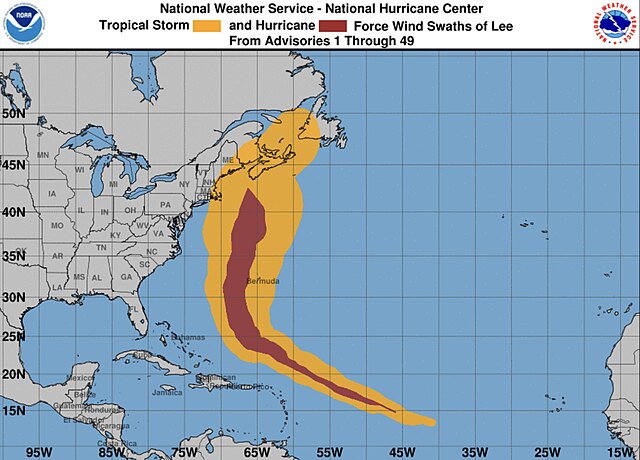Hurricane Lee was a long-lived and intense Cape Verde hurricane which impacted Bermuda, the Northeastern United States, and Eastern Canada in September 2023. The twelfth named storm, fourth hurricane, and third major hurricane of the 2023 Atlantic hurricane season, Lee formed on September 5 from a tropical wave that had moved offshore from West Africa into the tropical Atlantic a few days earlier. A strong steering current caused the storm to track northwestward, far from the Northern Leeward Islands. Highly favorable conditions enabled Lee to rapidly intensify to a Category 5 hurricane on September 7, its winds increased by 85 mph (140 km/h) in 24 hours. This made it the third‑fastest rapid intensification on record in the Atlantic, only behind Hurricane Wilma in 2005 and Hurricane Felix in 2007. Just as quickly however, Lee's strength waned, and it fluctuated in intensity for several days on account of strong wind shear and multiple eyewall replacement cycles.

Lee at peak intensity to the east of the Leeward Islands on September 8
Satellite Imagery of Hurricane Lee at Peak Intensity in the Late Hours of September 7
Hurricane Lee's wind field history
Lee as a post-tropical cyclone making landfall in Nova Scotia on September 16
Tropical cyclones and subtropical cyclones are named by various warning centers to simplify communication between forecasters and the general public regarding forecasts, watches and warnings. The names are intended to reduce confusion in the event of concurrent storms in the same basin. Once storms develop sustained wind speeds of more than 33 knots, names are generally assigned to them from predetermined lists, depending on the basin in which they originate. Some tropical depressions are named in the Western Pacific, while tropical cyclones must contain a significant amount of gale-force winds before they are named in the Southern Hemisphere.
Hurricane Lee at peak intensity to the east of the Leeward Islands in September 2023
Hurricane Walaka at peak intensity south of Johnston Atoll in October 2018
Typhoon Bolaven at its peak intensity over the Pacific Ocean in October 2023
Typhoon Egay at peak intensity off the coast of northern Luzon in July 2023







